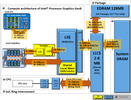Intel Iris Plus Graphics 650 vs Intel Iris Pro Graphics 6200 vs Intel HD Graphics P630
Intel Iris Plus Graphics 650
► remove from comparison
Die Intel Iris Plus Graphics 650 (GT3e) ist eine Prozessorgrafikkarte der im Jänner 2017 vorgestellten Kaby-Lake-Modelle. Als Nachfolger der Intel Iris Graphics 550 (Skylake) ist die Iris Plus Graphics 650 dabei in den Modellen der 28-Watt-Klasse zu finden und besitzt einen dedizierten eDRAM-Cache mit 64 MB Kapazität. Technisch dürfte es kaum Unterschiede zur Iris Graphics 550 geben.
Die sogenannte GT3e-Ausbaustufe der Kaby-Lake-GPU verfügt wahrscheinlich weiterhin über 48 Execution Units (EUs), die je nach Modell mit bis zu 1.100 MHz takten. Neben dem eDRAM-Cache kann die Iris 650 auch über das Interface des Prozessors auf den Hauptspeicher zugreifen (2x 64 Bit DDR3L-1600/DDR4-2400).
Von der Iris Plus 640 der 15-Watt-Modelle unterscheidet sich die Iris 650 lediglich durch ihren etwas höheren Maximaltakt sowie die annähernd verdoppelte TDP, die eine bessere Ausnutzung des Turbo-Boost-Spielraumes erlaubt.
Performance
Die exakte Leistung der Iris Plus Graphics 650 hängt vom jeweiligen CPU-Modell ab, da sich die Maximaltaktrate sowie die Größe des L3-Caches leicht unterscheiden können. Zum anderen beeinflusst auch der verwendete Speicher (DDR3/DDR4) die Performance.
Die höchste Leistung erreichen hochtaktende Core-i7-Ableger wie der Core i7-6567U. Je nach Spiel ordnet sich die Iris Plus 650 vermutlich im Bereich einer dedizierten GeForce 930M ein und kann aktuelle Titel (Stand 2015) in niedrigen bis mittleren Einstellungen flüssig darstellen.
Features
Die überarbeitete Videoeinheit dekodiert H.265-/HEVC-Videos vollständig in Hardware. Anders als Skylake kann Kaby Lake nun auch H.265/HEVC im Main10-Profil mit 10 Bit Farbtiefe sowie Googles VP9-Codec in Hardware dekodieren. Die Bildausgabe erfolgt über DP 1.2/eDP 1.3 (max. 3.840 x 2.160 @ 60 Hz), wohingegen HDMI nur in der älteren Version 1.4a angeboten wird. Ein HDMI-2.0-Anschluss kann aber mittels Konverter von DisplayPort ergänzt werden. Maximal lassen sich drei Displays parallel angesteuern.
Leistungsaufnahme
Die Iris Plus Graphics 650 ist in den Prozessoren der 28-Watt-Klasse zu finden und damit für mittelgroße Laptops geeignet.
Intel Iris Pro Graphics 6200
► remove from comparison
Die Intel Iris Pro Graphics 6200 (GT3e) ist eine Prozessorgrafikkarte in den CPUs der Broadwell-Generation und das schnellste Modell ihrer Baureihe. Die GPU wird in einigen 47-Watt-Modellen der Core-Serie verbaut (z.B. Core i7-5750HQ) und bietet 48 EUs (Execution Units bzw. Ausführungseinheiten) sowie einen schnellen eDRAM-Cache. Die Taktrate der Grafikkarte hängt vom konkreten Modell ab und beträgt bis zu 1.150 MHz (Turbo).
Architektur und Features
Broadwell integriert eine Grafikeinheit auf Basis der Intel-Gen8-Architektur, die gegenüber dem Vorgänger Intel Gen7.5 (Haswell) in verschiedenen Punkten weiterentwickelt wurde. So hat Intel unter anderem die "Subslice" genannten Shader-Arrays umorganisiert, die nun jeweils 8 Execution Units (EUs) beinhalten. Drei Subslices bilden wiederum einen Slice mit insgesamt 24 EUs. Hinzu kommen größere L1-Caches und Verbesserungen im Front-End, die die Leistung zusätzlich steigern sollen.
Die Iris Pro Graphics 6200 repräsentiert die größte, auch "GT3e" genannte Ausbaustufe mit zwei Slices und dementsprechend 48 EUs. Im Gegensatz zur einfachen "GT3"-Variante mit ebenfalls 48 EUs (HD Graphics 6000, Iris Graphics 6100) verfügt die GT3e zusätzlich über den bereits erwähnten eDRAM-Cache mit 128 MB Kapazität.
Alle Broadwell-GPUs unterstützen OpenCL 2.0 sowie DirectX 12 (FL 11_1). Zudem kann der Videodecoder nun auch den H.265-Codec verarbeiten, greift dafür allerdings nur teilweise auf besonders sparsame Fixed-Function-Einheiten zurück. Die Bildausgabe erfolgt über DP 1.2/eDP 1.3 (max. 3.840 x 2.160 @ 60 Hz) oder HDMI 1.4a (max. 3.840 x 2.160 @ 24 Hz), HDMI 2.0 steht dagegen nicht zur Verfügung. Es können maximal drei Displays parallel angesteuert werden.
Performance
Erste Benchmarks sehen die Iris Graphics 6200 etwa 15 Prozent oberhalb des Vorgängermodells Iris Pro Graphics 5200 und damit auf Augenhöhe mit einer GeForce GT 750M (DDR3) oder GeForce 940M. Unterm Strich reicht die Leistung, um viele Spiele des Jahres 2015 (z.B. GTA V, Battlefield Hardline, Dirt Rally) in 1.366 x 768 Pixeln und mittleren Einstellungen flüssig wiederzugeben. Einige sehr anspruchsvolle Titel wie The Witcher 3 können jedoch eine weitere Reduzierung der Details erfordern.
Leistungsaufnahme
Die TDP des gesamten Chips inklusive Prozessor liegt typischerweise bei 47 Watt, sodass die Iris Pro Graphics 6200 vor allem in mittelgroßen Notebooks zu finden ist. Bei einigen Modellen kann die TDP bei Bedarf auch auf 37 Watt abgesenkt werden, was sich jedoch negativ auf die Leistungsfähigkeit auswirkt.
Intel HD Graphics P630
► remove from comparison
Die Intel HD Graphics P630 (GT2) ist eine integrierte Workstation-Grafikeinheit, die in verschiedenen Desktop- und Notebook-Prozessoren der 2017 vorgestellten Kaby-Lake-Generation zu finden ist (Xeon E3-1200 v6 und e3-1500M v6 Serien). Sie ist identisch mit der Intel HD Graphics 630, jedoch sind die Treiber für professionelle Software optimiert. Daher unterscheidet sie sich auch nicht von der Intel HD Graphics P530 und erreicht laut Intel auch die selbe Leistung im SPEC Viewperf12 (1.94x der alten Intel HD Graphics P4000). Die Grafikkarte ist derzeit für 15 CAD- und Workstation-Anwendungen zertifiziert.
Features
Neu bei der Kaby-Lake Generation ist die verbesserte Videoengine, welche nun auch H.265/HEVC im Main10-profil mit 10 Bit Farbtiefe sowie Googles VP9-Codec in Hardware dekodieren kann. Die Chips mit HD Graphics 530 sollten auch bereits HDCP 2.2 unterstützen und somit z.B. Netflix-Videos unter Windows 10 in 4K ausgeben können (im Gegensatz zu den ersten Kaby-Lake Dual-Core Chips mit Intel HD Graphics 620).
Leistungsaufnahme
Die HD Graphics P630 ist in Desktop- und Notebook-Prozessoren verschiedener TDP-Klassen zu finden. Die Quad-Core CPUs sind jedoch meistens in größeren und schwereren Notebooks verbaut. Der verbesserte 14nm+ Prozess verspricht jedoch eine etwas geringere Leistungsaufnahme im Vergleich zur Intel HD Graphics P530.
Quelle: http://www.intel.com/content/dam/www/public/us/en/documents/guides/hd-graphics-performance-guide.pdf
| Intel Iris Plus Graphics 650 | Intel Iris Pro Graphics 6200 | Intel HD Graphics P630 | |||||||||||||||||||||||||||||||||||||||||||||||||||||||||||||||||||||||||||||||||||||||||||
| Gen. 9.5 Serie |
|
|
| ||||||||||||||||||||||||||||||||||||||||||||||||||||||||||||||||||||||||||||||||||||||||||
| Codename | Kaby Lake GT3e | Broadwell GT3e | Kaby-Lake-H-GT2 | ||||||||||||||||||||||||||||||||||||||||||||||||||||||||||||||||||||||||||||||||||||||||||
| Architektur | Gen. 9.5 Kaby Lake | Gen. 8 Broadwell | Gen. 9.5 Kaby Lake | ||||||||||||||||||||||||||||||||||||||||||||||||||||||||||||||||||||||||||||||||||||||||||
| Pipelines | 48 - unified | 48 - unified | 24 - unified | ||||||||||||||||||||||||||||||||||||||||||||||||||||||||||||||||||||||||||||||||||||||||||
| Kerntakt | 300 - 1100 (Boost) MHz | 300 - 1150 (Boost) MHz | |||||||||||||||||||||||||||||||||||||||||||||||||||||||||||||||||||||||||||||||||||||||||||
| Speicherbandbreite | 64/128 Bit | eDRAM + 64/128 Bit | 64/128 Bit | ||||||||||||||||||||||||||||||||||||||||||||||||||||||||||||||||||||||||||||||||||||||||||
| Speichertyp | DDR4 | ||||||||||||||||||||||||||||||||||||||||||||||||||||||||||||||||||||||||||||||||||||||||||||
| Shared Memory | ja | ja | ja | ||||||||||||||||||||||||||||||||||||||||||||||||||||||||||||||||||||||||||||||||||||||||||
| API | DirectX 12_1, OpenGL 4.4 | DirectX 12 (FL 11_1), OpenGL 4.3 | DirectX 12_1, OpenGL 4.4 | ||||||||||||||||||||||||||||||||||||||||||||||||||||||||||||||||||||||||||||||||||||||||||
| Herstellungsprozess | 14 nm | 14 nm | 14 nm | ||||||||||||||||||||||||||||||||||||||||||||||||||||||||||||||||||||||||||||||||||||||||||
| Features | QuickSync | QuickSync | QuickSync | ||||||||||||||||||||||||||||||||||||||||||||||||||||||||||||||||||||||||||||||||||||||||||
| Erscheinungsdatum | 03.01.2017 | 02.06.2015 | 05.08.2015 | ||||||||||||||||||||||||||||||||||||||||||||||||||||||||||||||||||||||||||||||||||||||||||
| Notebookgröße | mittel (15.4" z.B.) |
|
|
| ||||||||||||||||||||||||||||||||||||||||||||||||||||||||||||||||
Benchmarks
Cinebench R15 OpenGL 64 Bit + Intel Iris Plus Graphics 650
Average Benchmarks Intel Iris Plus Graphics 650 → 100% n=2
Average Benchmarks Intel Iris Pro Graphics 6200 → 122% n=2
Average Benchmarks Intel HD Graphics P630 → 77% n=2
* Smaller numbers mean a higher performance
1 This benchmark is not used for the average calculation
Spiele-Benchmarks
Die folgenden Benchmarks basieren auf unseren Spieletests mit Testnotebooks. Die Performance dieser Grafikkarte bei den gelisteten Spielen ist abhängig von der verwendeten CPU, Speicherausstattung, Treiber und auch Betriebssystem. Dadurch müssen die untenstehenden Werte nicht repräsentativ sein. Detaillierte Informationen über das verwendete System sehen Sie nach einem Klick auf den fps-Wert.

Dirt 4
2017
Rocket League
2017
Prey
2017
For Honor
2017
Dishonored 2
2016
Titanfall 2
2016
Farming Simulator 17
2016
Battlefield 1
2016
Civilization VI
2016
Overwatch
2016
The Division
2016
Far Cry Primal
2016
Rainbow Six Siege
2015
Dota 2 Reborn
2015
The Witcher 3
2015
GTA V
2015
BioShock Infinite
2013Average Gaming Intel Iris Plus Graphics 650 → 100%
Average Gaming 30-70 fps → 100%
| Intel Iris Plus Graphics 650 | low | med. | high | ultra | QHD | 4K |
|---|---|---|---|---|---|---|
| Dirt 4 | 64 | 21.3 | 14.2 | |||
| Rocket League | 113 | 56.8 | 38.9 | |||
| Prey | 51.4 | 20.2 | ||||
| Mass Effect Andromeda | 25.8 | 10.5 | ||||
| Ghost Recon Wildlands | 17.6 | |||||
| For Honor | 39.7 | 15.2 | ||||
| Dishonored 2 | 15 | |||||
| Call of Duty Infinite Warfare | 32.4 | |||||
| Titanfall 2 | 54.1 | 37.9 | ||||
| Farming Simulator 17 | 36.8 | 19.9 | ||||
| Battlefield 1 | 46.1 | 29.5 | ||||
| Civilization VI | 42.2 | 20.2 | ||||
| Deus Ex Mankind Divided | 19.2 | 14.6 | 8.2 | |||
| Overwatch | 79.2 | 57.4 | 25.6 | 21.4 | ||
| The Division | 30 | |||||
| Far Cry Primal | 32 | 15 | ||||
| Rise of the Tomb Raider | 25.9 | 18.3 | ||||
| Rainbow Six Siege | 54.2 | 35.6 | 20.8 | |||
| Dota 2 Reborn | 95 | 64 | 29.7 | 25 | ||
| The Witcher 3 | 21.4 | |||||
| GTA V | 56.5 | 49.9 | 11.6 | 5 | ||
| BioShock Infinite | 84 | 54.4 | 46.5 | 13.3 | ||
| < 30 fps < 60 fps < 120 fps ≥ 120 fps | 6 10 5 | 9 6 1 | 6 3 | 5 | | |
Eine Liste mit weiteren Spielen und allen Grafikkarten finden Sie auf unserer Seite: Welches Spiel ist mit welcher Grafikkarte spielbar?

















